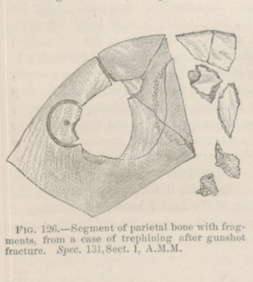Title: C——, L——
Source text: Surgeon General Joseph K. Barnes, United States Army, The Medical and Surgical History of the War of the Rebellion. (1861–65.), Part 1, Volume 2 (Washington, D.C.: Government Printing Office, 1870), 262.
Civil War Washington ID: med.d1e16647
TEI/XML: med.d1e16647.xml
CASE.—Private L—— C——, Co. B, 2d Pennsylvania Reserves, was wounded at Chantilly, Virginia, September 1st, 1862, by a round ball, which comminuted and depressed the right parietal bone, two inches below the sagittal suture. He became insensible and remained so for about fifteen minutes, when he recovered and walked about. He was admitted to the Harewood Hospital, Washington, D. C., on the 4th, having full power over his limbs and a good appetite. Gradually he began to feel depressed, then confined himself to his bed, and finally, on the 7th, was seized with paraplegia. On the evening of the 9th, he had become unconscious. A cathartic was administered, which operated freely, and the next morning the patient was fully conscious again and complained of pain in the head. At five o clock P. M., of the following day he was unable to move, and his voice thick and inarticulate. His left side was nearly insensible, but warm, and he could protrude his tongue only partially. On examining the wound, a depression of the size of a twenty-five cent piece was found, but evidently no ball lodged in the brain. Chloroform was administered, and the fragments being so pressed into each other, that neither elevator nor forceps could remove them, the trephine was applied by Surgeon I. Moses, U. S. V., and the bone sawed nearly through, which loosened the pieces so that they were readily removed. The dura mater and surface of the brain were torn. Bleeding from a small branch of the temporal artery was easily checked, and the parts were covered with ice-cold water. Three and a half hours after the operation he had considerably improved; the severe pain which he had complained of for days previous to operation and the paraplegia were relieved. He slept soundly on the night of the 11th, but on the following morning a constant gurgling in his throat could be heard. Pus and blood were continually discharged from the wound, which looked well. He sank rapidly, became comatose on the morning of the 13th, and died in the afternoon of that day. The pathological specimen, No. 131, Sect. I, A. M. M., shows a partially trephined segment of the right parietal bone, with five fragments, embracing one square inch. The outer table and diploë were cut through, but not removed, by the trephine applied on the sound bone at the edge of the fracture. The specimen and history were contributed by Surgeon I. Moses, U. S. V.
